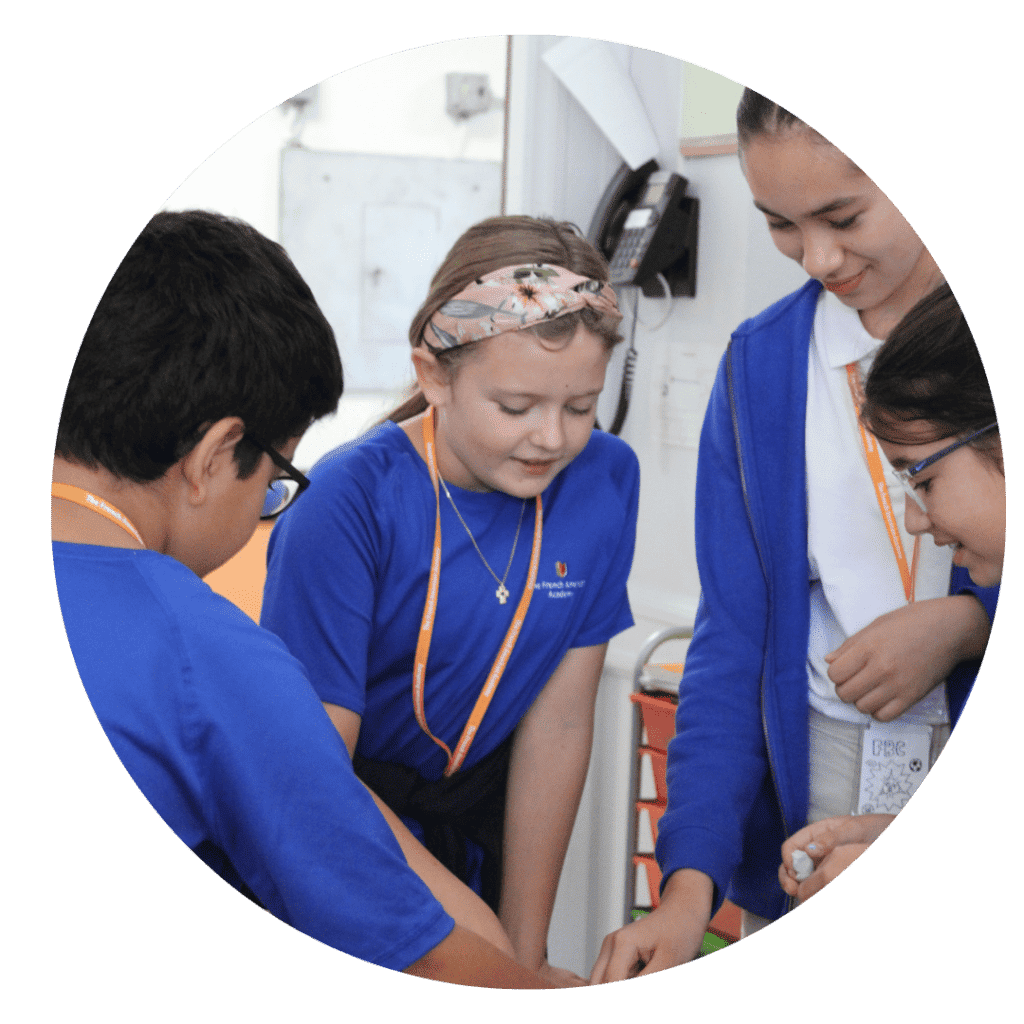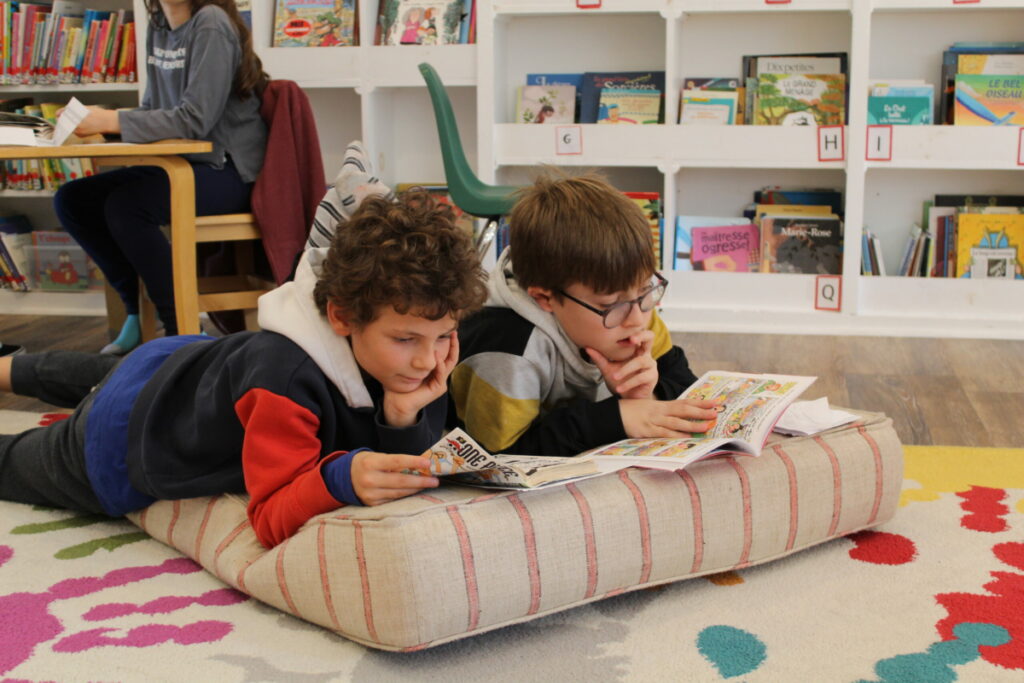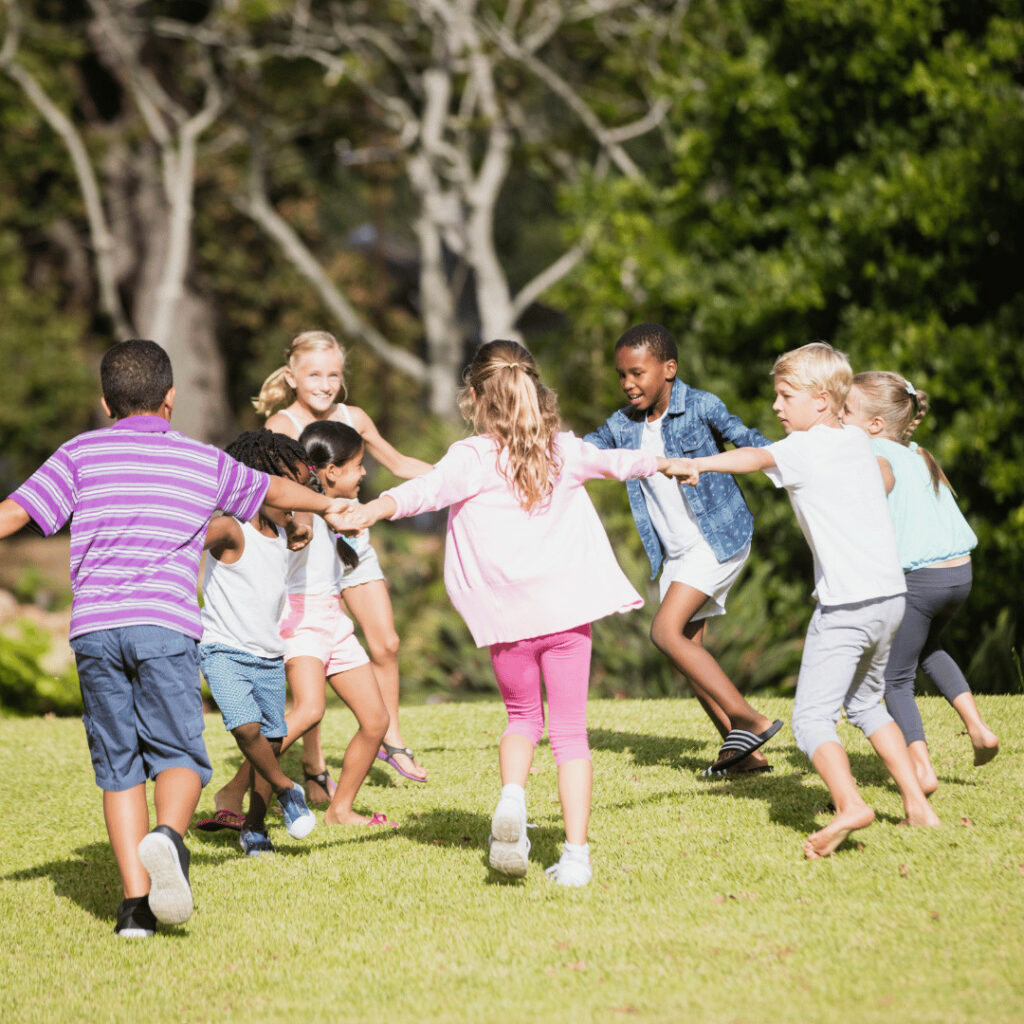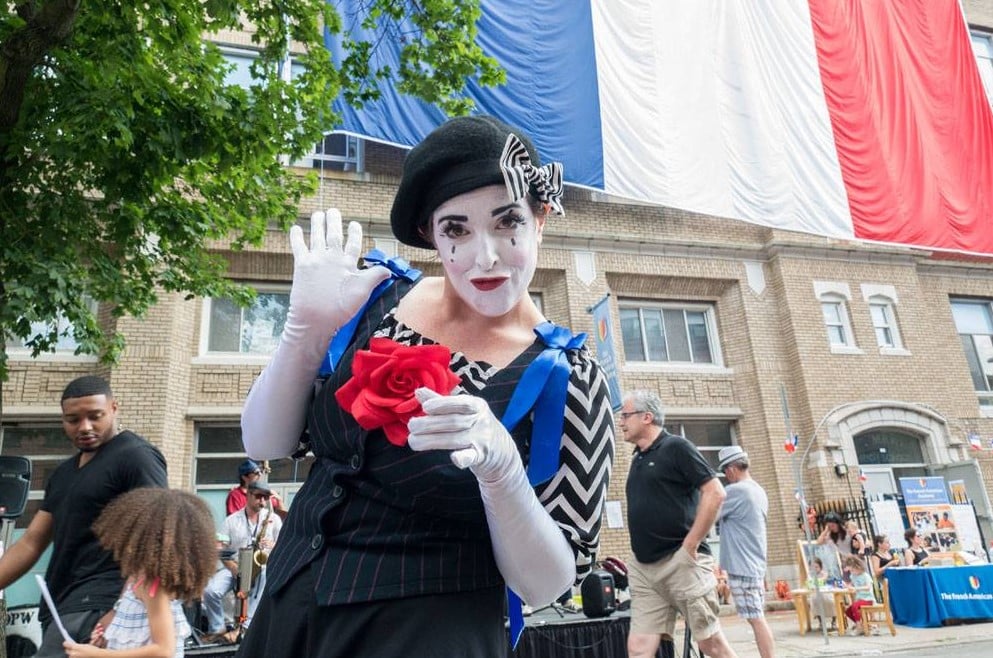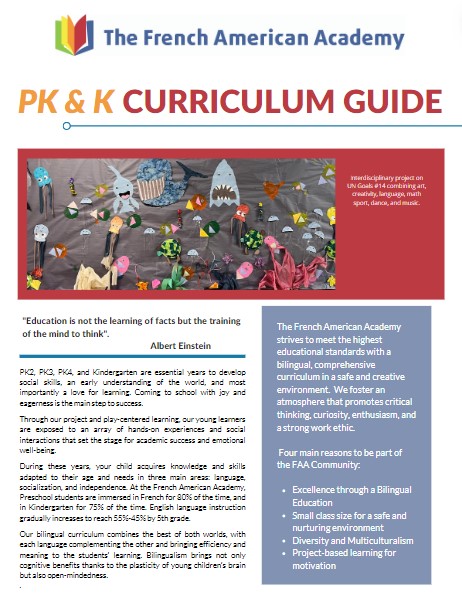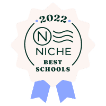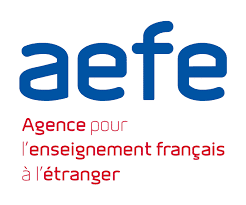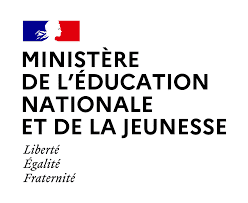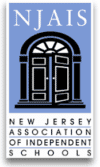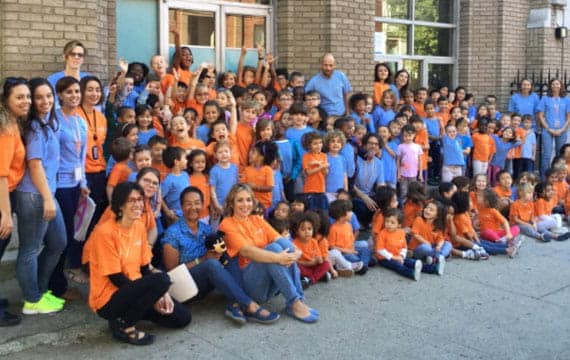Preschool & Kindergarten
Our Approach
Through the dual lenses of French and English, we immerse our young learners in a supportive and nurturing learning environment that helps them develop a sense of self, self-awareness, and an early understanding of their world from two perspectives.
Through our project and play-centered learning, our students are exposed to an array of hands-on experiences and social interactions that set the stage for academic success and a love of learning.
*French knowledge is not required for Preschool and Kindergarten enrollment.
Bilingualism
in Preschool & Kindergarten
Developing Cognitive Abilities
Bilingualism is a powerful tool for brain development. By switching between two languages throughout the day, more synapses are fired, strengthening cognitive connections and accelerating brain development compared to students exposed to only one language.
At our international preschool, students are immersed in French 80% of the time. Research shows that early exposure to a second language in an immersive setting helps children absorb grammar and language structures more effectively. As they progress, we gradually increase English instruction, reaching a balanced 55% French and 45% English by elementary school.
Learning Through Play
How We Teach
The main objective of our play-based curriculum (which evolves into a project-based approach in elementary and middle school) is to cultivate a lifelong love of learning. Research on early childhood development has consistently shown that children learn best when having fun, and for preschool-aged children, fun emerges through play.
Our preschool classes integrate learning objectives into purposeful, play-based activities with teacher guidance. These activities include structured games, building, drawing, singing, and dancing. Through this playful learning approach, students gain a deeper understanding of concepts through active exploration.
Most importantly, our teachers take into account each child’s interests and unique abilities, supporting their individual growth in a fun, engaging, and structured learning environment.
3 Key Pillars of the Preschool & Kindergarten Program
Socialization
We are preparing our students to become confident leaders. Through structured games and morning gatherings, students learn how to engage as classroom community members and collaborate and communicate effectively with their peers.
Independence
We engage students in activities that promote responsibility and autonomy, allowing them to develop a strong sense of self as individuals. We aim to help students take pride in their identities and grow their self-confidence.
Language Aquisition
Oral language is the foundation of all learning. Students develop reading and writing skills by acquiring sounds, syllables, and phonics in both languages. This strong language base also supports mathematical understanding as students learn to articulate mathematical concepts, share problem-solving strategies, and discuss numbers and patterns.
Preschool & Kindergarten Curriculum
All aspects of the curriculum are enhanced through multisensory activities that stimulate curiosity, promote critical thinking, and develop social skills. It is important to note that these skills are part of the 6Cs framework, which we reinforce throughout the school’s curriculum.
The curriculum for Preschool and Kindergarten is organized into five interconnected domains.
Social and Emotional Development / Becoming a Student
Inspired by the Responsive Classroom Approach, this domain is one of our core educational program’s keystones. The Responsive Classroom Approach promotes success across all areas of the curriculum. For instance, children enhance their relationships with peers and develop self-awareness. They also learn to adapt to classroom rules, practice self-regulation, and collaborate effectively. As a result, they become more autonomous and accountable by taking an active role in the life of the class.
Read our blog to learn about the social-emotional development skills your child will gain in Preschool and Kindergarten.
English and French Language Arts
In all areas of our international preschool’s curriculum, children acquire a growing receptive and expressive new vocabulary in both languages. For example, they practice oral skills via meaningful communication during targeted language activities and spontaneous conversation. Then, over time, they improve syntax structure and understand and follow spoken directions.
The more they practice, the more our students demonstrate an understanding of the organization of print, syllables, and sounds (phonemes). Moreover, they display reading behaviors. Eventually, children read independently in English at the end of Kindergarten and are ready to begin the first grade’s formal French reading program.
Additionally, in Kindergarten, students participate in a co-teaching class where they start working on comparative grammar, allowing them to deepen their understanding of both languages and their structures.
Cognition and Knowledge of the World (Science, Mathematics and Social Studies)
In mathematics, children learn about numbers and their applications. They develop a strong understanding of quantity, recognize organized patterns, and identify and describe shapes. Similarly, in science, children think critically by making predictions, manipulating materials, observing, and defining the characteristics of living things, objects, and matter. They demonstrate their understanding by explaining “how” and “why.”
Additionally, children develop an awareness of time and space. They learn about their own community and their own culture while also discovering other cultures, people, and places.
The Arts
Students express themselves and represent their knowledge, thoughts, beliefs, and feelings through visual art and creative movement. Additionally, students enhance their dexterity by practicing fine motor skills in activities such as drawing, painting, and crafting while nurturing their artistic expression.
Gross and Fine Motor development
Students enhance their body awareness, spatial awareness, coordination, and control through daily physical fitness activities. They also develop the hand-eye coordination and dexterity required for manipulating small objects during fine motor skills activities.
Bilingual Science
In our preschool science program, French- and English-speaking teachers co-teach, creating an immersive environment where students naturally develop vocabulary and concepts in both languages. This co-teaching approach enhances cognitive flexibility and strengthens connections between linguistic and scientific thinking. [This bilingual co-teaching approach starts in science in PK but will be extended throughout the grades to language (starting in Kindergarten) and mathematics (starting in 3rd Grade)]
Students develop critical thinking and analytical skills through hands-on experimentation, guided questioning, and research-based exploration. They engage with fundamental scientific topics such as the seasons, life cycles of plants and animals, sustainable development, and states of matter while reinforcing essential temporal benchmarks and spatial landmarks.
Participation in challenges and events like the science fair provides opportunities for students to present their discoveries, fostering confidence, communication skills, and a love for scientific inquiry from an early age.
Pre-K vs Kindergarten:
What's the difference?
In this article, we discuss the key differences and similarities between Pre-K and kindergarten classroom activities.
Day in the Life of a Preschooler
Preschool
In our international preschool, early learning is an essential step in the students’ journey to guarantee academic excellence and success. Thus, in PreK2, PreK3, and PreK4, children learn to become autonomous and develop an early sense of self as an individual. Supported by their teachers, they interact and live together through active engagement in a positive environment. Moreover, they get a healthy start and develop autonomy, strengthen oral language and discover writing and number concepts. Likewise, they begin to experiment in science, develop physically through gross motor activities and create artistic projects.
| Time | Schedule |
| 8:15 am to 8:30 am | Drop-off |
| 8:30 am to 8:45 am | Morning Meeting |
| 8:45 am to 9:15 am | Language workshop, constructing numbers, world discovery + workshops to build autonomy |
| 9:15 am to 9:45 am | Motricity activities & sports |
| 9:45 am to 10:30 am | Snack time + Outdoor time |
| 10:30 am to 11 am | Arts (painting, collages, etc…) |
| 11 am to 11:30 am | Language workshop, constructing numbers, world discovery + workshops to build autonomy |
| 11:30 am to 11:45 am | Classroom cleanup |
| 11:45 pm to 12:30 pm | Lunch Time |
| 12:30 pm to 12:45 pm | Bathroom time + falling asleep |
| 12:45 pm to 2:15 pm | Nap time (need based) |
| 2:15 pm to 2:45 pm | Language workshop, constructing numbers, world discovery + workshops to build autonomy |
| 2:45 pm to 3:00 pm | End of the day meeting on the rug |
Kindergarten
Kindergarten is an exciting transition as students blend what they have learned in preschool with more structured academic activities and routines. As a result, Kindergarten plays a pivotal role between early childhood and elementary school. This is the grade where students begin the formal reading program in English and become independent readers and problem solvers.
Practical Information | Preschool & Kindergarten at Glance
- Amount of Instruction in French: 80%
- Age of Admission: 2.5 years old by December 31st.
- Admission requirements: Potty training is not required.
- Teacher-student ratio: 1 to 6 students
- Amount of Instruction in French: 80%
- Age of Admission: 3 years old by December 31st.
- Admission requirements: Students must be potty trained.
- Teacher-student ratio: 1 to 8 students
- Amount of Instruction in French: 70%
- Age of Admission: 4 years old by December 31st.
- Admission requirements: Student must be potty trained.
- Teacher-student ratio: 1 to 8 students
- Amount of Instruction in French: 70%
- Age of Admission: 5 years old by December 31st.
- Teacher-student ratio: 1 to 9 students
- Program Schedule: Full-time: Monday through Friday, 8:30 am to 3:15 pm, half-day sessions available.
- Before-school care: 7:30am to 8:am.
- After-school care: 3:00 pm to 6:30 pm. Enrichment program available
Field Trips
Learning beyond the classroom
We understand that real-world experience is essential for a child’s growth, which is why we organize exciting field trips that complement what student are learning in class.
From visiting the local firehouse and learning about fire safety to exploring the wonders of science at the Liberty Science Center, or appreciating art at the Montclair Art Museum, our preschool students experience different environments outside the classroom, enhancing their education.
In elementary & middle school, day trips become overnight trips! Learn more by checking out our field trip page!
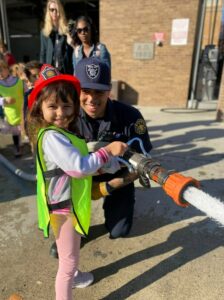
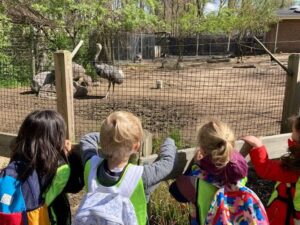
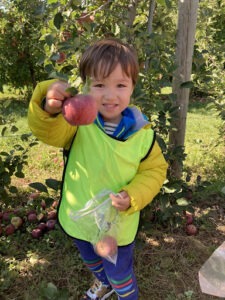
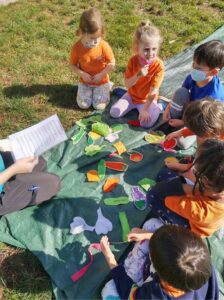
Discover What's New in Preschool & Kindergarten
Behind the Scenes
Preschool and Kindergarten
Before the end of the school year, our preschool to elementary school students took part in a flash mob and performed the song "On a gagné" by our music teacher, Josephine. They practiced with Josephine during music class for this special project. It was a lot of work, but everyone – students, teachers, staff, and parents – worked together to create a memorable moment for all. It was a joyful experience, and we were all excited to see the final result. A big "thank you" to everyone who participated in this project!
#downtownjc #grovestreetjc #thefrenchamericanacademy #internationalschool #preschoolinjc #elementaryschoolinjerseycity #downtownjerseycity
#website

Before the end of the school year, our preschool to elementary school students took part in a flash mob and performed the song "On a gagné" by our music teacher, Josephine. They practiced with Josephine during music class for this special project. It was a lot of work, but everyone – students, teachers, staff, and parents – worked together to create a memorable moment for all. It was a joyful experience, and we were all excited to see the final result. A big "thank you" to everyone who participated in this project!
#downtownjc #grovestreetjc #thefrenchamericanacademy #internationalschool #preschoolinjc #elementaryschoolinjerseycity #downtownjerseycity
#website
…
At our Open House, you`ll have the opportunity to gain insights into our educational philosophy and curriculum for Preschool through 9th Grade from our Head of School, school directors, and teachers. You`ll also be able to interact with our dedicated teachers and tour our classrooms. Additionally, interactive workshops will be offered, providing a firsthand experience of FAA`s unique approach to bilingual education. Refreshments will be served.

At our Open House, you`ll have the opportunity to gain insights into our educational philosophy and curriculum for Preschool through 9th Grade from our Head of School, school directors, and teachers. You`ll also be able to interact with our dedicated teachers and tour our classrooms. Additionally, interactive workshops will be offered, providing a firsthand experience of FAA`s unique approach to bilingual education. Refreshments will be served. …
Last Thursday, Pre-K2 to Kindergarten students at the Jersey City Campus also participated in a spirit run to raise funds. They ran nonstop for 24 minutes, with students giving it their all until the end!
The funds will support the Georgie Badiel Foundation and Konekte, helping build wells in Burkina Faso for clean water and providing projectors to schools in Haiti, improving education for over 1,000 children. Our continued partnerships with these organizations create a lasting positive impact in the communities we serve.
#website

Last Thursday, Pre-K2 to Kindergarten students at the Jersey City Campus also participated in a spirit run to raise funds. They ran nonstop for 24 minutes, with students giving it their all until the end!
The funds will support the Georgie Badiel Foundation and Konekte, helping build wells in Burkina Faso for clean water and providing projectors to schools in Haiti, improving education for over 1,000 children. Our continued partnerships with these organizations create a lasting positive impact in the communities we serve.
#website
…
Did you know the FAA has a mascot? It`s a dolphin! The FAA Dolphins! We thought it was the perfect time to show it off, especially now that we have a competitive Middle School Basketball Team set to compete in the Hudson County Sports League and the AEFE Competition in Chicago.
The mascot was decided some years ago but had never been officially designed, so we thought, what better way than to have our students design it? After all, we`re a project-based learning school!
Throughout September, students from preschool to 8th grade submitted their artwork, both digital and hand-drawn. After carefully reviewing the submissions, we are excited to announce the winners. Sofia, Cameron, and Juliana from 6th grade worked together on a design and won the award for the best slogan. Natalia from 5th grade created the winning dolphin design and color scheme.
Because the decision was so difficult, we had to have several honorary mentions. Be sure to check out the photos to see all the amazing designs!
A professional designer then brought the students` designs and slogans to life, creating our official mascot which will be featured on our Basketball Team Jerseys (1st picture)!
#FAA #Mascot #Dolphin #MiddleSchoolBasketball #HudsonCountySportsLeague #ProjectBasedLearning #StudentDesigns #Artwork #Winners #DesignContest #OfficialMascot #StudentArt #CreativeKids #internationalbilingualschool #frenchamericanschool #privateschoolinnj

Did you know the FAA has a mascot? It`s a dolphin! The FAA Dolphins! We thought it was the perfect time to show it off, especially now that we have a competitive Middle School Basketball Team set to compete in the Hudson County Sports League and the AEFE Competition in Chicago.
The mascot was decided some years ago but had never been officially designed, so we thought, what better way than to have our students design it? After all, we`re a project-based learning school!
Throughout September, students from preschool to 8th grade submitted their artwork, both digital and hand-drawn. After carefully reviewing the submissions, we are excited to announce the winners. Sofia, Cameron, and Juliana from 6th grade worked together on a design and won the award for the best slogan. Natalia from 5th grade created the winning dolphin design and color scheme.
Because the decision was so difficult, we had to have several honorary mentions. Be sure to check out the photos to see all the amazing designs!
A professional designer then brought the students` designs and slogans to life, creating our official mascot which will be featured on our Basketball Team Jerseys (1st picture)!
#FAA #Mascot #Dolphin #MiddleSchoolBasketball #HudsonCountySportsLeague #ProjectBasedLearning #StudentDesigns #Artwork #Winners #DesignContest #OfficialMascot #StudentArt #CreativeKids #internationalbilingualschool #frenchamericanschool #privateschoolinnj
…
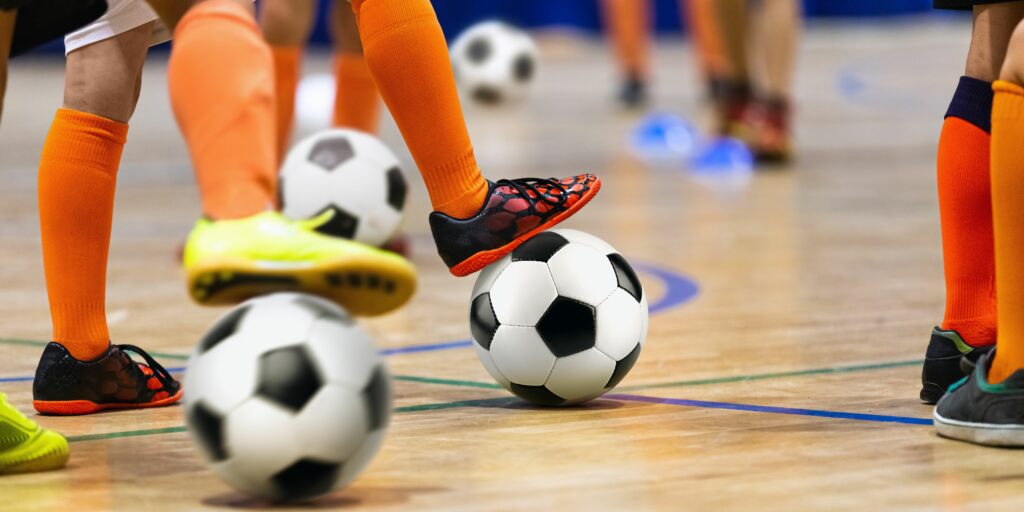
Enrichment Program
Continuing student learning after-school
Our after-school enrichment program offers students a variety of activities to discover new passions while having fun!
Examples of current enrichment activities include:
- Lego Robotics
- Woodworking
- Yoga & Mindfulness
- Sports (Gymnastics / soccer / basketball, etc)
- Piano
- Cooking
- Acting in French
- Modern Dance
- Chess
- and much more!
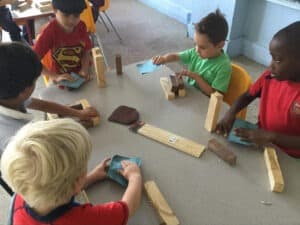
Discover our Campuses
Englewood & Jersey City
All of our International preschool locations at the French American Academy follow the same curriculum and philosophy. Learn more about our New Jersey preschools in Jersey City, Hoboken, and Englewood.
Preschool & Kindergartner FAQs
Will my child's English skills decline if they learn French?
Learning a second language does not mean a child’s brain will have less space for the first language. In fact, research suggests that learning a second language can actually stimulate brain development and improve cognitive skills. Learn more.
At our international preschool, our goal is to provide students with a strong bilingual foundation in both English and French. We understand that while English is widely spoken in our community, it is important to actively immerse students in the French language in order to achieve proficiency. We are dedicated to providing instruction and opportunities for our students to thrive in both languages.
My child already speaks 2 languages. Will learning a 3rd language be overwhelming for them?
Learning a third language is a rewarding and enriching experience for a child, especially at a young age. Research suggests that being exposed to multiple languages has numerous benefits for cognitive and language development. Children have a natural ability to learn languages and are often able to pick up new languages more easily than adults. So, if your child is already proficient in two languages, learning a third language may come more naturally to them.
Don’t hesitate to encourage your child to take on this challenge and expand their linguistic abilities – they may surprise you with their progress and success
How can we support our child if we do not speak French at home?
As an international preschool, we are proud to welcome a diverse student body, with over 42% of families who do not speak any French at home. Don’t worry, this is not new for us!
Here are some ways you can support your child in their French language studies at home, even if you do not speak French yourself:
- Encourage your child to practice their French skills regularly, whether it be through homework assignments or additional language exercises.
- Provide a quiet and distraction-free environment for your child to do their French work in.
- Sit down with your child and ask them to explain their homework and what they have learned in their French class. This can help reinforce their understanding of the material and give you an idea of what they are struggling with or excelling in. You can also ask your child to teach you a few phrases or words in French to help them feel more confident and to show your interest in their studies.
- Encourage your child to use resources such as language learning apps, books, and videos to improve their skills.
- Encourage your child to listen to French music and watch French films or television shows to expose them to the language in a natural and enjoyable way.
- Talk to your child’s teacher about additional resources and support that may be available to help your child succeed in their French studies.
- Be supportive and encouraging of your child’s language learning journey, and celebrate their progress and accomplishments along the way.
Where do the teachers come from?
At our International Preschool at the French American Academy, all of our French teachers are from countries where French is the official language and speak French as their native language and our English teachers are native English speakers.
Do preschoolers have regular opportunities to leave the classroom?
Our preschoolers leave their classrooms daily to engage in a variety of activities. They have scheduled daily gross motor skills class in the gym and, weather permitting, they visit Hamilton Park or our courtyard daily during recess. Preschoolers also visit our library, cafeteria, nap room, music room, and other areas of our school on a regular basis. In addition, we have a range of school events that provide additional opportunities for our preschoolers to explore and learn in new environments.
We believe that providing a diverse range of experiences is important for a child’s development, and we strive to offer a wide range of activities for our preschoolers to participate in.
How frequently do preschoolers go outside?
Preschoolers at the French American Academy go outside as often as possible, weather permitting. They have scheduled outdoor time daily and may go to a nearby park or to our courtyard during recess and special activities.
We prioritize providing opportunities for our preschoolers to go outside and explore the outdoors as we believe it is important for their physical and cognitive development.
Do the preschoolers have the opportunity to visit the school's library?
Our large library is a bright and welcoming place, perfect for cozy story times with the librarian.
Preschoolers visit the library at least once a week to enjoy a variety of books, but they also have access to additional books in their classrooms where their teachers also read to them. We believe that reading is an important part of a child’s development and strive to provide plenty of opportunities for our preschoolers to explore the joys of literature
Is the French American Academy a Montessori preschool?
At our international preschool at the French American Academy, we are inspired and include some Montessori core beliefs in our curriculum, but we are more than just a Montessori preschool. Our educational approach goes further than only Montessori core beliefs. We proactively promote 21st-century skills required in today’s world, bilingualism, project/play-based instruction, and global citizenship.
Montessori Core beliefs we include in our curriculum:
- small class size to give students individualized attention
- embracing life-based teaching
- promoting independence among children
- manipulatives that link math and geography to day-to-day life
Preschool and Kindergarten serving Englewood, NJ (Bergen County), Jersey City, NJ, and the greater NYC area.

